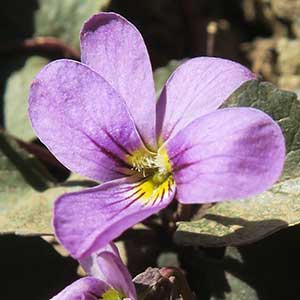Viola flettii
Viola guadalupensis
Flett's violet, Olympic violet, rock violet
Guadalupe Mountains violet, Guadalupe violet
1–3, ascending to erect, mostly glabrous, on caudex from fleshy rhizome.
1–5, decumbent to erect, leafy proximally and distally, glabrous, on caudex from fleshy rhizome.
basal and cauline;
basal: 1–3;
stipules linear-lanceolate, margins entire or with glandular processes, apex acuminate;
petiole 1.5–9.7 cm, mostly glabrous;
blade purple-tinted and –veined, broadly reniform to ovate, 0.9–2.4 × 1.2–4 cm, base cordate, margins finely crenate-serrate, eciliate, apex acute to obtuse, surfaces glabrous or sparsely pubescent along veins adaxially;
cauline similar to basal except: stipules ovate to lanceolate, margins entire or shallowly laciniate;
petiole 0.7–5.9 cm, usually glabrous;
blade 0.8–2.1 × 1.2–3.1 cm.
cauline;
stipules lanceolate to ovate- or oblong-lanceolate or linear, margins sparingly glandular-fimbriate, apex acute;
petiole 2–6 cm, glabrous;
blade ovate to ovate-deltate or ovate-lanceolate, 1.2–2.4 × 0.7–1.3 cm, base broadly cuneate to rounded or truncate, margins entire or with 1–3 crenations on proximal 1/2, eciliate, apex acute to rounded, surfaces glabrous, sometimes with a few short hairs on veins abaxially.
1.8–7.1 cm, usually glabrous.
3.5–6 cm, glabrous.
sepals lanceolate, margins eciliate, auricles 0.5–1.5 mm;
petals soft reddish violet on both surfaces, all with yellow area basally, lower 3 dark violet-veined, lateral 2 bearded, lowest with white around yellow area, 10–15 mm, spur yellow, gibbous, 0.5–2 mm;
style head bearded; cleistogamous flowers axillary.
sepals linear to linear-lanceolate, margins eciliate, auricles 0.5–1.5 mm;
petals deep lemon-yellow adaxially, upper 2 reddish brown abaxially, lateral 2 and lowest dark brown-veined basally, lateral 2 bearded, lowest 7–11 mm, spur yellow, gibbous, 1–1.4 mm;
style head bearded; cleistogamous flowers absent.
± spherical, 5–9 mm, glabrous.
ovoid, 3–4.5 mm, glabrous.
dark brown to brownish purple, 2.5–3 mm.
light brown, ± 2 mm.
= 24.
Viola flettii
Viola guadalupensis
Viola flettii is endemic to the Olympic Mountains of northwestern Washington. C. S. McCreary (2005) noted that although morphologically and ecologically distinct, V. cuneata, V. flettii, and V. ocellata are closely related.
(Discussion copyrighted by Flora of North America; reprinted with permission.)
Of conservation concern.
Viola guadalupensis is known only from the eastern rim of the Guadalupe Mountains in Culberson County. Powell and Wauer noted that it is the only yellow-flowered violet known in the Guadalupe Mountains and appears to be related to V. nuttallii and V. vallicola. K. W. Allred (2008) stated that a report of this species in New Mexico by J. T. Kartesz and C. A. Meacham (1999) requires verification. K. Haskins (pers. comm.) reported that experiments are currently being conducted to propagate plants of V. guadalupensis via cell tissue culture.
Chloroplast (trnL-F spacer) and low-copy nuclear gene (GPI) phylogenies indicate that Viola guadalupensis is an alloploid that originated through hybridization between an unidentified member of subsect. Canadenses (the paternal parent) and a member of the V. nuttallii complex
(the maternal parent), of sect. Chamaemelanium (T. Marcussen et al. 2011). Evidence reported by these authors from a fossil-calibrated relaxed clock dating analysis showed the estimated maximum age of V. guadalupensis to be (5.7–)8.6(–11.6) million years.
(Discussion copyrighted by Flora of North America; reprinted with permission.)


